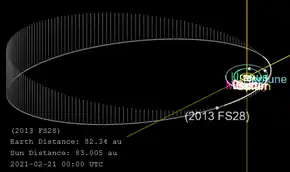 Orbit of 2013 FS28 | |
| Discovery[1][2] | |
|---|---|
| Discovered by | (first observed only) S. S. Sheppard[3] C. Trujillo[3] |
| Discovery site | Cerro Tololo Obs. |
| Discovery date | 16 March 2013 |
| Designations | |
| 2013 FS28 | |
| TNO[4] · ESDO[5] · ETNO distant[1] | |
| Orbital characteristics[4] | |
| Epoch 2021-Jul-01 (JD 2459396.5) | |
| Uncertainty parameter 5 | |
| Observation arc | 7.85 yr (2866 d) |
| Aphelion | 241.1±2 AU (Q) |
| Perihelion | 35.64±0.05 AU (q) |
| 138.4±1.2 AU (a) | |
| Eccentricity | 0.742±0.003 (e) |
| 1627±22 years | |
| 338°±0.35° (M) | |
| 0° 0m 1.44s / day | |
| Inclination | 13.09°±0.002° (i) |
| 204.6°±0.001° (Ω) | |
| ≈ December 2119[6] ±1 year[lower-alpha 1] | |
| 104.8°±0.09° (ω) | |
| Neptune MOID | 9.1 AU[1] |
| Physical characteristics | |
Mean diameter | 464 km (est.)[5] 468 km (est.)[7] |
| 0.07 (assumed)[7] 0.09 (assumed)[5] | |
| 4.9[1][4] | |
2013 FS28 is an extreme trans-Neptunian object from the extended scattered disc on a highly eccentric orbit in the outermost region of the Solar System. It measures approximately 466 kilometers (290 miles) in diameter. The detached, extended scattered disc object belongs to the group of extreme trans-Neptunian objects. It was first observed on 16 March 2013, by American astronomers Scott Sheppard and Chad Trujillo at the Cerro Tololo Observatory in Chile.[3][1][2]
Orbit and classification
2013 FS28 is 83 AU (12.4 billion km) from the Sun with a 7 year observation arc. It orbits the Sun at a distance of roughly 36–240 AU once every 1600 years. Its orbit has a high eccentricity of 0.7 and an inclination of 13° with respect to the ecliptic.[4] It has a minimum orbital intersection distance with Neptune of 9 AU.[1] The body's observation arc begins with its first official observation in March 2013, using the 4-meter Blanco Telescope at Cerro Tololo Observatory (807).[3][1]
It belongs to a small group of detached objects with perihelion distances of 30 AU or more, and semi-major axes of 150 AU or more.[8] Such extreme trans-Neptunian objects (ETNOs) can not reach such orbits without some perturbing object, which lead to the speculation of Planet Nine. It comes to perihelion (closest approach to the Sun) around December 2119.[lower-alpha 1]
Numbering and naming
As of 2018, this minor planet has neither been numbered nor named by the Minor Planet Center. The official discoverer(s) will be defined when the object is numbered.[1]
Physical characteristics
According to the Johnston's archive and to American astronomer Michael Brown, 2013 FS28 measures 464 and 468 kilometers in diameter based on an assumed albedo of 0.09 and 0.07, respectively.[5][7] As of 2018, no rotational lightcurve of has been obtained from photometric observations. The body's rotation period, pole and shape remain unknown.[4][9]
See also
Notes
References
- 1 2 3 4 5 6 7 8 "2013 FS28". Minor Planet Center. Retrieved 25 October 2018.
- 1 2 "List Of Centaurs and Scattered-Disk Objects". Minor Planet Center. Retrieved 25 October 2018.
- 1 2 3 4 Sheppard, S. S.; Trujillo, C. (August 2016). "2013 FS28". Minor Planet Electronic Circular. 2016-Q38 (2016–Q38). Bibcode:2016MPEC....Q...38S. Retrieved 25 October 2018.
- 1 2 3 4 5 "JPL Small-Body Database Browser: (2013 FS28)" (2014-05-02 last obs.). Jet Propulsion Laboratory. Retrieved 25 October 2018.
- 1 2 3 4 "List of Known Trans-Neptunian Objects". Johnston's Archive. 7 October 2018. Retrieved 25 October 2018.
- ↑ JPL Horizons Observer Location: @sun (perihelion occurs when deldot changes from negative to positive)
- 1 2 3 Brown, Michael E. "How many dwarf planets are there in the outer solar system?". California Institute of Technology. Retrieved 25 October 2018.
- ↑ "Database Query: objects q>30, a>150". Minor Planet Center. Retrieved 25 October 2018.
- ↑ "LCDB Data for (2013+FS28)". Asteroid Lightcurve Database (LCDB). Retrieved 25 October 2018.
External links
- List Of Centaurs and Scattered-Disk Objects, Minor Planet Center
- 2013 FS28 at AstDyS-2, Asteroids—Dynamic Site
- 2013 FS28 at the JPL Small-Body Database